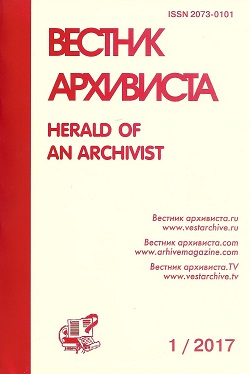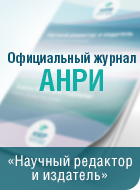Peculiarities of fixation of data on deposits in the records of the Dormition Tikhvin Monastery in the middle of the XVII century



Scientific article
doi 10.28995/2073-0101-2024-3-669-684
For citation
Abelentseva, Olga A. (2024), Peculiarities of fixation of data on deposits in the records of the Dormition Tikhvin monastery in the middle of the XVII century, Herald of an Archivist, № 3, pp. 669-684, doi 10.28995/2073-0101-2024-3-669-684
Abelentseva, Olga A., St. Petersburg Institute of History, Russian Academy of Sciences, St. Petersburg, Russia
Peculiarities of fixation of data on deposits in the records of the Dormition Tikhvin Monastery in the middle of the XVII century
Abstract
In the seventeenth century, clerical work in different monasteries could have its own peculiarities due to the nature of the way of life, local traditions and the level of qualification of monastic clerks. The written sources that emerged in the process of formation of commemorative practice in the Russian state include synodiks and contribution books, in which the names of contributors to churches and monasteries were recorded. The contribution books of the Assumption Tikhvin Monastery for the years 1560-1688 have been lost. The data of other sources containing information about contributions are available from 1623 onwards. The study of the documents on the basis of which the contribution books were compiled makes it possible to assess the degree of their reliability and completeness. The article presents the results of a comparative study of different types of documentation from the archives of the Assumption Tikhvin Monastery, into which records of contributions were successively copied for inclusion in the contribution books and synodics. The first and most important group of such sources, both in terms of completeness and number, are the incoming money books. They recorded all contributions that had a monetary component: full contributions for tonsure, contributions to be recorded in the lithium synodik for eternal commemoration, and small contributions for a specified period of time. Few draft records of contributions in the form of columns and notebooks have been preserved in Q°so, but their existence allows us to analyze the order of data processing.
The study showed that the recording of contributions took place in several stages, at each of which rough and white records were made. Draft records of all types of deposits, including small ones, could be recorded on sheets in column form and in Q notebooks. They were then transcribed into the first type of draft entry books, also in column form. Further, records on full deposits were entered in Q notebooks, reconciled with entry books in the column, letters of deposit were issued to depositors, and appropriate notes were made on reconciliation and issuance of letters. At the next stage, the data on full deposits were transferred to F-format notebooks, from which a white deposit book was formed. In its turn, the incoming money books from the columns were also transcribed into draft and then into white Q notebooks. In this way, the data on deposits made were reconciled in documents of different purposes. The deposit books and synodic books were placed at the disposal of the kelar for further use in the process of fulfillment of obligations to the depositors. further use in the process of fulfillment of obligations to depositors. The contribution books were the accounting documentation of the treasurer, but they also to a great extent allow to reveal data on the composition of depositors in case of loss of the contribution books.
Keywords
Dormition Tikhvin monastery, contributions to the monastery, contribution book, monastery incoming money book, synodic, commemorative practice, monastery record keeping, historical sources.
Download the article: abelentseva_doi
References
Alekseev, A. I. (2010), The first edition of the contribution book of the Kirillov Belozersky Monastery (1560s), Herald of Church History, 2010, № 3-4 (19-20), pp. 17-117.
Dianova, T. V. (1996), Filigrees of the XVII-XVIII vv. “The Jester's Head”, Catalog, Issue, 94. Moscow, Russia, 165 p.
Dmitrieva, Z. V. (2017), The contribution book of the Kirillo-Belozersky Monastery (1559/1560-1620-es), Istoriya. Electronic scientific and educational journal, vol. 8, № 5 (59), https://history.jes.su/s207987840001876-2-1 (Accessed of 09.02.2024).
Emchenko, E. B. (2000), Stoglav: Research and text, Indrik, Moscow, Russia, 504 p.
Kuzmin, A. V., Strelnikov, S. V. (2008), Contribution books. IN: Orthodox Encyclopedia, vol. 8. Orthodox Encyclopedia, Moscow, Russia, pp. 613-617.
Marchenko, N. A. (2023), Novgorod bishops in the memorial practice of the Solovetsky monastery XV-XVII centuries, Ancient Russia. Voprosy medievistiki, № 2 (92), pp. 69-87.
Pavlov, A. P., Polyakov, I. A. (2023), Representatives of the princely-boyar nobility as contributors to the Dormition Tikhvin Monastery. IN: Novgorod Historical Collection, vol. 20 (30), Yaroslav the Wise Novgorod State University, Veliky Novgorod, Russia, pp. 218-228.
Strelnikov, S. V. (2016), To the question of duplicity of information about contributions in monastery documentation, St. Petersburg Historical Journal, № 2, pp. 155-165.
Strelnikov, S. V. (2006), To the question of the purpose of contribution letters and contribution books. IN: Sketches of feudal Russia, vol. 10, Alliance-Archeo, Moscow; St. Petersburg, Russia, pp. 58-74.
Strelnikov, S. V. (2013), Toward the Study of the Contribution Books of the Tikhvin Monastery, Ancient Russia. Voprosy medievistiki, № 3 (53), pp. 128-129.
Dmitrieva, Z. V., Sazonova, T. V. (2020), On Commemorative Practice In Kirillo-Belozersky Monastery (16th – the Beginning of 17th centuries). IN: European Proceedings of Social and Behavioural Sciences, vol. 108, Conference: International Scientific and Practical Conference «MAN. SOCIETY. COMMUNICATION», Veliky Novgorod, Russia, pp. 877–882.
Halperin, Charles J. (2017), Lay Cash Donations to the Trinity-Sergius Monastery during the Reign of Ivan IV. IN: The Slavonic and East European Review, vol. 95, № 2. April, pp. 271?292.
Martin, Russell E. (1999), Gifts for the Dead: Death, Kinship and Commemoration in Muscovy (The Case of the Mstislavskii Princes). IN: Russian History, vol. 26, № 2. Summer, pp. 171?202.
Spock, Jennifer B. (2007), Community Building and Social Identity: Donations to the Solovki Monastery 1460?1645. IN: Jahrb?cher f?r Geschichte Osteuropas, Neue Folge, bd. 55, h. 4, pp. 534?565.
Steindorff, Ludwig. (2007), Memorial Practice as a Means of Integrating the Muscovite State. IN: Jahrb?cher f?r Geschichte Osteuropas, vol. 55, pp. 517?533.
Steindorff, Ludwig. (2010), Donations and Commemorations in the Muscovite Realm – A Medieval or Early Modern Phenomenon. IN: Religion und Integration im Moskauer Russland. Konzepte und Praktiken, Potentiale und Grenzen, 14–17. Wiesbaden, Harrassowitz, pp. 477?478.
About the authors
Abelentseva Olga A., PhD historical sciences, St. Petersburg Institute of History, Russian Academy of Sciences, Department of Ancient History of Russia, Senior Researcher, St. Petersburg, Russia, 8-911-297-99-54, This e-mail address is being protected from spambots. You need JavaScript enabled to view it
The article was received in the editorial office on 19.04.2024, recommended for publication on 20.06.2024.











